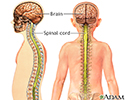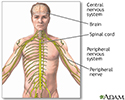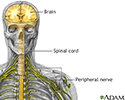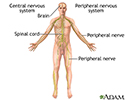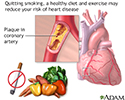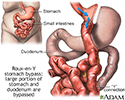Multimedia Gallery





Kidney transplant - series
Kidney transplant - series
The kidneys are paired organs that lie posterior to the abdomen, in the area of the lower back. The kidneys make urine, which is transported from the kidneys to the bladder by the ureters, long muscular tubes which connect the kidneys with the bladder.
Kidney transplant - series
Kidney transplant - series
The kidneys are paired organs that lie posterior to the abdomen, in the area of the lower back. The kidneys make urine, which is transported from the...
Kidney transplant - series
Indications
Kidney transplant may be recommended for patients with kidney failure caused by:
- Severe, uncontrollable high blood pressure (hypertension)
- Infections
- Diabetes mellitus
- Congenital abnormalities of the kidneys
- Other diseases which cause renal failure, such as autoimmune disease
Donor kidneys are obtained from either brain-dead organ donors, or from living relatives or friends of the recipient.
Kidney transplant - series
Indications
Kidney transplant may be recommended for patients with kidney failure caused by:Severe, uncontrollable high blood pressure (hypertension)InfectionsDi...
Kidney transplant - series
Incision
While the patient is deep asleep and pain-free (general anesthesia), an incision is made in the lower right quadrant of the abdomen. The donor kidney is transplanted into the right lower pelvis of the recipient.
Kidney transplant - series
Incision
While the patient is deep asleep and pain-free (general anesthesia), an incision is made in the lower right quadrant of the abdomen. The donor kidney...
Kidney transplant - series
Procedure
The new kidney is sutured into place. The vessels of the new kidney are connected to the vessels leading to the right leg (the iliac vessels), and the ureter is sutured to the bladder.
Kidney transplant - series
Procedure
The new kidney is sutured into place. The vessels of the new kidney are connected to the vessels leading to the right leg (the iliac vessels), and th...
Kidney transplant - series
Aftercare
In most cases, the recipient's native kidneys are left in place, and the transplanted kidney performs all the functions that both kidneys perform in healthy people. Kidney transplant recipients are required to take immunosuppressive medications for the rest of the lives, to prevent immune rejection of the transplanted organ.
Kidney transplant - series
Aftercare
In most cases, the recipient's native kidneys are left in place, and the transplanted kidney performs all the functions that both kidneys perform in ...
Review Date: 4/1/2025
Reviewed By: Kelly L. Stratton, MD, FACS, Associate Professor, Department of Urology, University of Oklahoma Health Sciences Center, Oklahoma City, OK. Also reviewed by David C. Dugdale, MD, Medical Director, Brenda Conaway, Editorial Director, and the A.D.A.M. Editorial team.
The kidneys are paired organs that lie posterior to the abdomen, in the area of the lower back. The kidneys make urine, which is transported from the kidneys to the bladder by the ureters, long muscular tubes which connect the kidneys with the bladder.
Kidney transplant may be recommended for patients with kidney failure caused by:
- Severe, uncontrollable high blood pressure (hypertension)
- Infections
- Diabetes mellitus
- Congenital abnormalities of the kidneys
- Other diseases which cause renal failure, such as autoimmune disease
Donor kidneys are obtained from either brain-dead organ donors, or from living relatives or friends of the recipient.
While the patient is deep asleep and pain-free (general anesthesia), an incision is made in the lower right quadrant of the abdomen. The donor kidney is transplanted into the right lower pelvis of the recipient.
The new kidney is sutured into place. The vessels of the new kidney are connected to the vessels leading to the right leg (the iliac vessels), and the ureter is sutured to the bladder.
In most cases, the recipient's native kidneys are left in place, and the transplanted kidney performs all the functions that both kidneys perform in healthy people. Kidney transplant recipients are required to take immunosuppressive medications for the rest of the lives, to prevent immune rejection of the transplanted organ.





Animations
- Blood pressure
- Bunion
- Cataract
- Childhood obesity
- Cholesterol and triglycerid...
- Coronary artery disease
- Depression
- Diabetes
- Diabetes - retinal conditions
- Diabetes and risk of seriou...
- Dialysis
- Erection problems
- Exercise
- Foot pain
- Gallstones
- Glaucoma
- Hardening of arteries
- HbA1c
- Healthy Guide to Fast Food
- Heart attack
- Hypertension
- Hypertension - overview
- Immune response
- Smoking
- Smoking tips to quit
- Stroke
- Stroke
- The goals of proper type 2 ...
- Tobacco use - effects on ar...
- Tracking your blood pressur...
- Type 1 diabetes
- Type 2 diabetes
- Understanding cholesterol r...
- Urinary incontinence
- Urinary tract infection - adults
- Vaccines
- Venous insufficiency
Illustrations
- 15/15 rule
- Abdominal girth measurement
- Abdominal muscles
- Acanthosis nigricans - close-up
- Acanthosis nigricans on the hand
- Acute MI
- Adjustable gastric banding
- Aerobic exercise
- Alpha-glucosidase inhibitors
- Angina
- Anterior heart arteries
- Atherosclerosis of the extr...
- Autonomic Nerves
- Baby bottle tooth decay
- Benefit of regular exercise
- Biguanides
- Blood pressure
- Blood pressure check
- Blood test
- Blood test
- Brain
- Brainstem function
- Calculating body frame size
- Candida - fluorescent stain
- Candidiasis, cutaneous - ar...
- Carotid dissection
- Carotid stenosis - X-ray of...
- Carpal tunnel syndrome
- Cataract - close-up of the eye
- Central nervous system
- Central nervous system and ...
- Cerebellum - function
- Childhood obesity
- Children's diets
- Cholesterol
- Cholesterol producers
- Circle of Willis
- Circulation of blood throug...
- Complex carbohydrates
- Coronary artery blockage
- Coronary artery disease
- Creatinine tests
- DASH diet
- Dermatitis - reaction to tinea
- Dermatitis - stasis on the leg
- Developmental process of at...
- Diabetes and exercise
- Diabetes and nerve damage
- Diabetes risk factors
- Diabetic blood circulation ...
- Diabetic emergency supplies
- Diabetic foot care
- Diabetic foot care
- Diabetic nephropathy
- Diabetic retinopathy
- Different types of weight gain
- Digestive system
- Endarterectomy
- Endocrine glands
- Energy levels
- Exercise - a powerful tool
- Exercise 30 minutes a day
- Exercise and age
- Exercise and heart rate
- Exercise can lower blood pr...
- Exercise with friends
- Eye
- Fast food
- Fasting plasma glucose test
- Female reproductive anatomy
- Female urinary tract
- Femoral nerve damage
- Fish in diet
- Flexibility exercise
- Follicle development
- Folliculitis - decalvans on...
- Folliculitis on the leg
- Food and insulin release
- Food label guide for candy
- Food label guide for whole ...
- Foot swelling
- Fruits and vegetables
- Fungus
- Gestational diabetes
- Gingivitis
- Gingivitis
- Glaucoma
- Glucose in blood
- Glucose test
- Granuloma - fungal (Majocchi's)
- Granuloma - fungal (Majocchi's)
- Granuloma annulare - close-up
- Granuloma annulare on the elbow
- Granuloma annulare on the eyelid
- Granuloma annulare on the legs
- Hair follicle anatomy
- Hammer toe
- Healthy diet
- Healthy diet
- Heart - front view
- Heart - section through the...
- Heart attack symptoms
- High blood pressure tests
- Influenza
- Influenza vaccines
- Ingrown toenail
- Insulin production and diabetes
- Insulin pump
- Insulin pump
- Islets of Langerhans
- Isometric exercise
- Jaw pain and heart attacks
- Kidney - blood and urine flow
- Kidney anatomy
- Kidneys
- Left cerebral hemisphere - ...
- Lifestyle changes
- Lipocytes (fat cells)
- Low blood sugar symptoms
- Male urinary system
- Male urinary tract
- Monitoring blood pressure
- myPlate
- Nail infection - candidal
- Necrobiosis lipoidica diabe...
- Necrobiosis lipoidica diabe...
- Nervous system
- Nervous system
- Normal uterine anatomy (cut...
- Obesity and health
- Omega-3 fatty acids
- Oral glucose tolerance test
- Osmolality test
- Pancreas
- Pancreas and kidneys
- Pelvic laparoscopy
- Pesticides and fruit
- Pharmacy options
- Physical activity - prevent...
- Pituitary and TSH
- Plaque buildup in arteries
- Pneumococcal vaccine
- Post myocardial infarction ...
- Posterior heart arteries
- Prevention of heart disease
- Progressive build-up of pla...
- Proteins
- Quitting smoking
- Radial nerve dysfunction
- Read food labels
- Retinal dye injection
- Right cerebral hemisphere -...
- Ringworm - tinea corporis o...
- Ringworm - tinea corporis o...
- Ringworm - tinea manuum on ...
- Ringworm - tinea on the han...
- Ringworm of the scalp
- Ringworm, tinea capitis - c...
- Roux-en-Y stomach surgery f...
- Salad nutrients
- Saturated fats
- Secondary infection
- Simple carbohydrates
- Slit-lamp exam
- Smoking hazards
- Sources of fiber
- Soy
- Stable angina
- Starchy foods
- Stein-Leventhal syndrome
- Stomach
- Stomach disease or trauma
- Stye
- Sulfonylureas drug
- Surface anatomy - normal palm
- Surface anatomy - normal wrist
- Swollen gums
- Thiazolidinediones
- Thyroid uptake test
- Tinea corporis - ear
- Tinea versicolor - close-up
- Tinea versicolor - close-up
- Tinea versicolor - shoulders
- Tinea versicolor on the back
- Tooth anatomy
- Tooth anatomy
- Trans fatty acids
- Type I diabetes
- Ulnar nerve damage
- Untreated hypertension
- Urine sample
- Uterus
- Vaginal discharge
- Visual field test
- Vitiligo
- Vitiligo - drug induced
- Vitiligo on the back and arm
- Vitiligo on the face
- Weight loss
- White nail syndrome
- Wood's lamp test - of the scalp
- Wrist anatomy
- Xerosis - close-up
- Yeast and mold
- Yeast infections
- Yoga
- Yo-yo dieting

 Bookmark
Bookmark


































































